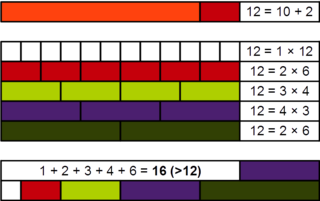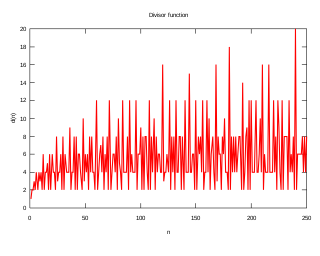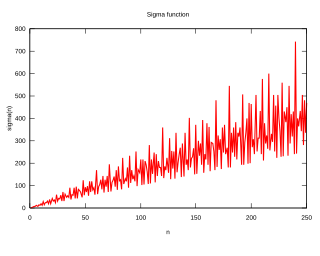Definition and overview
The aliquot sequence starting with a positive integer k can be defined formally in terms of the sum-of-divisors function σ1 or the aliquot sum function s in the following way: [1]
If the sn-1 = 0 condition is added, then the terms after 0 are all 0, and all aliquot sequences would be infinite, and we can conjecture that all aliquot sequences are convergent, the limit of these sequences are usually 0 or 6.
For example, the aliquot sequence of 10 is 10, 8, 7, 1, 0 because:
Many aliquot sequences terminate at zero; all such sequences necessarily end with a prime number followed by 1 (since the only proper divisor of a prime is 1), followed by 0 (since 1 has no proper divisors). See (sequence A080907 in the OEIS ) for a list of such numbers up to 75. There are a variety of ways in which an aliquot sequence might not terminate:
- A perfect number has a repeating aliquot sequence of period 1. The aliquot sequence of 6, for example, is 6, 6, 6, 6, ...
- An amicable number has a repeating aliquot sequence of period 2. For instance, the aliquot sequence of 220 is 220, 284, 220, 284, ...
- A sociable number has a repeating aliquot sequence of period 3 or greater. (Sometimes the term sociable number is used to encompass amicable numbers as well.) For instance, the aliquot sequence of 1264460 is 1264460, 1547860, 1727636, 1305184, 1264460, ...
- Some numbers have an aliquot sequence which is eventually periodic, but the number itself is not perfect, amicable, or sociable. For instance, the aliquot sequence of 95 is 95, 25, 6, 6, 6, 6, ... Numbers like 95 that are not perfect, but have an eventually repeating aliquot sequence of period 1 are called aspiring numbers. [2]
| n | Aliquot sequence of n | Length ( OEIS: A098007 ) |
|---|---|---|
| 0 | 0 | 1 |
| 1 | 1, 0 | 2 |
| 2 | 2, 1, 0 | 3 |
| 3 | 3, 1, 0 | 3 |
| 4 | 4, 3, 1, 0 | 4 |
| 5 | 5, 1, 0 | 3 |
| 6 | 6 | 1 |
| 7 | 7, 1, 0 | 3 |
| 8 | 8, 7, 1, 0 | 4 |
| 9 | 9, 4, 3, 1, 0 | 5 |
| 10 | 10, 8, 7, 1, 0 | 5 |
| 11 | 11, 1, 0 | 3 |
| 12 | 12, 16, 15, 9, 4, 3, 1, 0 | 8 |
| 13 | 13, 1, 0 | 3 |
| 14 | 14, 10, 8, 7, 1, 0 | 6 |
| 15 | 15, 9, 4, 3, 1, 0 | 6 |
| 16 | 16, 15, 9, 4, 3, 1, 0 | 7 |
| 17 | 17, 1, 0 | 3 |
| 18 | 18, 21, 11, 1, 0 | 5 |
| 19 | 19, 1, 0 | 3 |
| 20 | 20, 22, 14, 10, 8, 7, 1, 0 | 8 |
| 21 | 21, 11, 1, 0 | 4 |
| 22 | 22, 14, 10, 8, 7, 1, 0 | 7 |
| 23 | 23, 1, 0 | 3 |
| 24 | 24, 36, 55, 17, 1, 0 | 6 |
| 25 | 25, 6 | 2 |
| 26 | 26, 16, 15, 9, 4, 3, 1, 0 | 8 |
| 27 | 27, 13, 1, 0 | 4 |
| 28 | 28 | 1 |
| 29 | 29, 1, 0 | 3 |
| 30 | 30, 42, 54, 66, 78, 90, 144, 259, 45, 33, 15, 9, 4, 3, 1, 0 | 16 |
| 31 | 31, 1, 0 | 3 |
| 32 | 32, 31, 1, 0 | 4 |
| 33 | 33, 15, 9, 4, 3, 1, 0 | 7 |
| 34 | 34, 20, 22, 14, 10, 8, 7, 1, 0 | 9 |
| 35 | 35, 13, 1, 0 | 4 |
| 36 | 36, 55, 17, 1, 0 | 5 |
| 37 | 37, 1, 0 | 3 |
| 38 | 38, 22, 14, 10, 8, 7, 1, 0 | 8 |
| 39 | 39, 17, 1, 0 | 4 |
| 40 | 40, 50, 43, 1, 0 | 5 |
| 41 | 41, 1, 0 | 3 |
| 42 | 42, 54, 66, 78, 90, 144, 259, 45, 33, 15, 9, 4, 3, 1, 0 | 15 |
| 43 | 43, 1, 0 | 3 |
| 44 | 44, 40, 50, 43, 1, 0 | 6 |
| 45 | 45, 33, 15, 9, 4, 3, 1, 0 | 8 |
| 46 | 46, 26, 16, 15, 9, 4, 3, 1, 0 | 9 |
| 47 | 47, 1, 0 | 3 |
The lengths of the aliquot sequences that start at n are
- 1, 2, 2, 3, 2, 1, 2, 3, 4, 4, 2, 7, 2, 5, 5, 6, 2, 4, 2, 7, 3, 6, 2, 5, 1, 7, 3, 1, 2, 15, 2, 3, 6, 8, 3, 4, 2, 7, 3, 4, 2, 14, 2, 5, 7, 8, 2, 6, 4, 3, ... (sequence A044050 in the OEIS )
The final terms (excluding 1) of the aliquot sequences that start at n are
- 1, 2, 3, 3, 5, 6, 7, 7, 3, 7, 11, 3, 13, 7, 3, 3, 17, 11, 19, 7, 11, 7, 23, 17, 6, 3, 13, 28, 29, 3, 31, 31, 3, 7, 13, 17, 37, 7, 17, 43, 41, 3, 43, 43, 3, 3, 47, 41, 7, 43, ... (sequence A115350 in the OEIS )
Numbers whose aliquot sequence terminates in 1 are
- 1, 2, 3, 4, 5, 7, 8, 9, 10, 11, 12, 13, 14, 15, 16, 17, 18, 19, 20, 21, 22, 23, 24, 26, 27, 29, 30, 31, 32, 33, 34, 35, 36, 37, 38, 39, 40, 41, 42, 43, 44, 45, 46, 47, 48, 49, 50, ... (sequence A080907 in the OEIS )
Numbers whose aliquot sequence known to terminate in a perfect number, other than perfect numbers themselves (6, 28, 496, ...), are
- 25, 95, 119, 143, 417, 445, 565, 608, 650, 652, 675, 685, 783, 790, 909, 913, ... (sequence A063769 in the OEIS )
Numbers whose aliquot sequence terminates in a cycle with length at least 2 are
- 220, 284, 562, 1064, 1184, 1188, 1210, 1308, 1336, 1380, 1420, 1490, 1604, 1690, 1692, 1772, 1816, 1898, 2008, 2122, 2152, 2172, 2362, ... (sequence A121507 in the OEIS )
Numbers whose aliquot sequence is not known to be finite or eventually periodic are
- 276, 306, 396, 552, 564, 660, 696, 780, 828, 888, 966, 996, 1074, 1086, 1098, 1104, 1134, 1218, 1302, 1314, 1320, 1338, 1350, 1356, 1392, 1398, 1410, 1464, 1476, 1488, ... (sequence A131884 in the OEIS )
A number that is never the successor in an aliquot sequence is called an untouchable number.
- 2, 5, 52, 88, 96, 120, 124, 146, 162, 188, 206, 210, 216, 238, 246, 248, 262, 268, 276, 288, 290, 292, 304, 306, 322, 324, 326, 336, 342, 372, 406, 408, 426, 430, 448, 472, 474, 498, ... (sequence A005114 in the OEIS )














